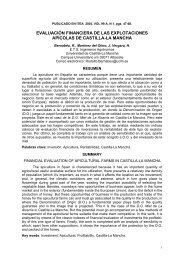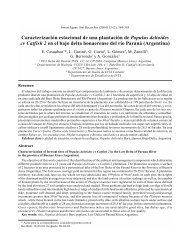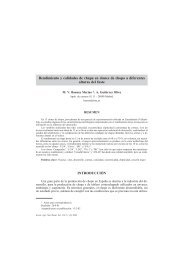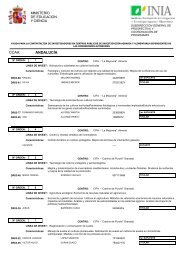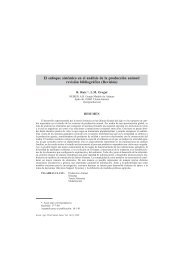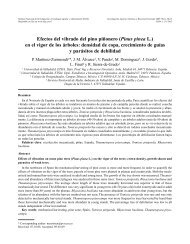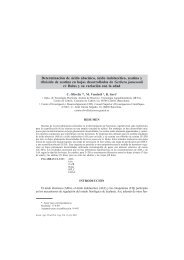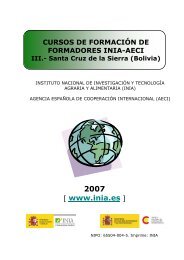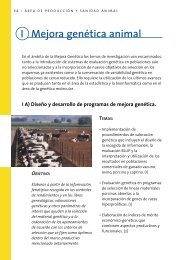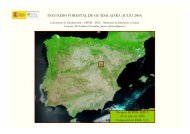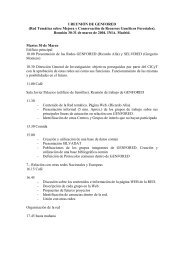Status of medicinal and aromatic plants in - Inia
Status of medicinal and aromatic plants in - Inia
Status of medicinal and aromatic plants in - Inia
Create successful ePaper yourself
Turn your PDF publications into a flip-book with our unique Google optimized e-Paper software.
16<br />
WORKING GROUP ON MEDICINAL AND AROMATIC PLANTS: FIRST MEETING<br />
• Supranational legislation (e.g. European Union)<br />
Unlike <strong>in</strong>ternational treaties that cannot be directly implemented, the legislation <strong>of</strong> the<br />
European Communities has an immediate legal effect on the member states. Most important<br />
for plant conservation are:<br />
- The Habitat Directive (Council Directive 92/43/EEC <strong>of</strong> 21 May 1992 on the conservation <strong>of</strong><br />
natural habitats <strong>and</strong> <strong>of</strong> wild fauna <strong>and</strong> flora – OJ L 206, 22.7.1992) def<strong>in</strong><strong>in</strong>g a list <strong>of</strong> plant<br />
species (Annex II) that require habitat protection <strong>and</strong> are part <strong>of</strong> the NATURA 2000<br />
ecological network, a list <strong>of</strong> strictly protected <strong>plants</strong> (Annex IV) <strong>and</strong> a list <strong>of</strong> <strong>plants</strong> that<br />
can be utilized <strong>in</strong> a managed way (Annex V).<br />
- The Endangered Species Regulation (Council Regulation (EC) No. 338/97 <strong>of</strong> 9 December 1996<br />
on the protection <strong>of</strong> species <strong>of</strong> wild fauna <strong>and</strong> flora by regulat<strong>in</strong>g trade there<strong>in</strong> – OJ L 61,<br />
3. 3. 1997) regulates the trade <strong>of</strong> threatened species.<br />
• Strategies<br />
Long-term goal sett<strong>in</strong>g <strong>and</strong> a vision for conservation are set up by strategic documents.<br />
Some global documents that were the basis for the preparation <strong>of</strong> some <strong>in</strong>ternational<br />
conventions (e.g. the CBD) <strong>and</strong> national activities are mentioned below.<br />
- 1980: World Conservation Strategy (IUCN, UNEP, WWF)<br />
- 1991: Car<strong>in</strong>g for the Earth (IUCN, UNEP, WWF)<br />
- 1992: Global Biodiversity Strategy (WRI, IUCN, UNEP)<br />
Specially focused on <strong>medic<strong>in</strong>al</strong> <strong>plants</strong> are the Guidel<strong>in</strong>es on the conservation <strong>of</strong> <strong>medic<strong>in</strong>al</strong><br />
<strong>plants</strong> (WHO, IUCN, WWF), published <strong>in</strong> 1993. Selected guidel<strong>in</strong>es, more related to the topic<br />
<strong>of</strong> our meet<strong>in</strong>g, are mentioned below:<br />
- basic studies: study traditional knowledge <strong>of</strong> plant uses, identify <strong>medic<strong>in</strong>al</strong> <strong>plants</strong>,<br />
study distribution <strong>and</strong> ecology;<br />
- utilization: wherever possible, to cultivate <strong>medic<strong>in</strong>al</strong> <strong>plants</strong> as the source <strong>of</strong> supply;<br />
ensure susta<strong>in</strong>able collect<strong>in</strong>g from the wild;<br />
- <strong>in</strong> situ <strong>and</strong> ex situ conservation <strong>of</strong> <strong>medic<strong>in</strong>al</strong> plant populations;<br />
- build public support, ensure equitable shar<strong>in</strong>g <strong>of</strong> benefits.<br />
In the framework <strong>of</strong> the CBD the Global Strategy for Plant Conservation was developed <strong>in</strong><br />
2002. The overall goals <strong>of</strong> the strategy are quite ambitious:<br />
- no species <strong>of</strong> wild flora to be endangered by <strong>in</strong>ternational trade;<br />
- 30% <strong>of</strong> plant-based products derived from sources that are susta<strong>in</strong>ably managed;<br />
- the decl<strong>in</strong>e <strong>of</strong> plant resources, <strong>and</strong> associated local <strong>and</strong> <strong>in</strong>digenous knowledge,<br />
<strong>in</strong>novations <strong>and</strong> practices that support susta<strong>in</strong>able livelihoods, local food security <strong>and</strong><br />
health care, to be halted.<br />
These goals were further elaborated at the European level through the Planta Europa<br />
Network <strong>in</strong> the European Plant Conservation Strategy (2002) which deals with specific regional<br />
aspects, go<strong>in</strong>g <strong>in</strong> some cases beyond global goals, sett<strong>in</strong>g clear goals <strong>and</strong> targets. Target 3.1<br />
is specially related to conservation <strong>and</strong> use <strong>of</strong> <strong>plants</strong>: "Best practise for the conservation <strong>and</strong><br />
susta<strong>in</strong>able use <strong>of</strong> <strong>medic<strong>in</strong>al</strong> <strong>plants</strong> (<strong>and</strong> other sociologically important <strong>plants</strong>) identified <strong>and</strong> promoted<br />
to relevant policy-makers."<br />
• M<strong>in</strong>isterial processes<br />
M<strong>in</strong>isterial processes can also serve plant conservation. Most relevant are Environment for<br />
Europe (meet<strong>in</strong>g <strong>of</strong> m<strong>in</strong>isters responsible for the environment) <strong>and</strong> Protection <strong>of</strong> Forests <strong>in</strong><br />
Europe (m<strong>in</strong>isters responsible for forests).




